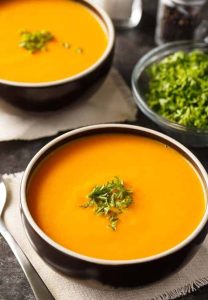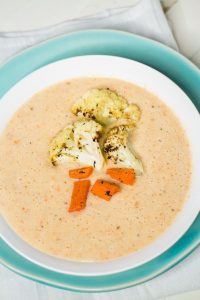How to Make Pureed Soup with Vegetable? Vegetable soup is a delicious and nutritious meal option. But for those who have trouble chewing or swallowing, a pureed version can be a lifesaver. Here, we’ll delve into the wonderful world of pureed vegetable soups!
This article equips you with the knowledge to create smooth, flavorful pureed soups at home. We’ll cover essential steps, explore creative flavor combinations, and address common questions.
Gather Your Arsenal: Essential Ingredients
Here’s a basic shopping list to get you started. Don’t hesitate to customize these based on your preferences!
- Vegetables: This is the star of the show! Choose a variety of your favorites. Some popular options include carrots, potatoes, broccoli, peas, and corn.
- Broth or Stock: Vegetable broth or low-sodium chicken broth adds flavor and liquid to your soup.
- Aromatics: Onion, garlic, and herbs like thyme or rosemary can add depth of flavor.
- Seasonings: Salt, pepper, and a squeeze of lemon juice can enhance the taste.
- Optional Additions: For creamier texture, you can add milk, cream cheese, or even avocado.
Souper Techniques: Cooking Your Vegetables
There are a few different ways to cook your vegetables for pureed soup. Here are two common methods:
Simmering:
This is a gentle cooking method that allows the vegetables to soften and release their flavor. Simply add your chopped vegetables and broth to a pot and simmer over medium heat until tender.
Roasting:
Roasting vegetables can add a deeper, caramelized flavor. Toss your chopped vegetables with a bit of olive oil and roast in a preheated oven at 400°F (204°C) until tender.
Once your vegetables are cooked, it’s time for the fun part: pureeing!
The Puree Process: Transforming Vegetables into Velvet
There are a few tools you can use to achieve a smooth puree:
- Immersion Blender: An immersion blender lets you puree your soup directly in the pot. This is a convenient option.
- Blender or Food Processor: Transfer your cooked vegetables and broth to a blender or food processor and puree until smooth. Use caution when blending hot liquids.
Here are some tips for achieving a perfect puree:
- Start with hot ingredients: Hotter vegetables will blend more easily.
- Add liquid gradually: Start with a little broth and add more as needed to reach your desired consistency.
- Don’t over-blend: Over-blending can make your soup gluey. Stop when you reach a smooth consistency.
Flavor Fiesta: Exploring Variations
The beauty of homemade soup is the endless creativity! Here are some ideas to inspire you:
- Classic Creamy Tomato: Puree roasted tomatoes with garlic, herbs, and a touch of cream for a comforting and flavorful soup.
- Spicy Sweet Potato: Roast sweet potatoes, onions, and peppers. Puree with vegetable broth and a touch of chili powder for a smoky and sweet soup.
- Garden Green Goddess: Puree a variety of green vegetables like broccoli, spinach, and peas with vegetable broth and a squeeze of lemon juice for a light and refreshing soup.
Beyond the Basics: Adding Pizazz
Once you’ve mastered the basic puree, there are ways to elevate your soup:
- Garnishes: Dollop on some plain yogurt, a swirl of pesto, or a sprinkle of chopped fresh herbs for extra flavor and texture.
- Bread Pairings: Serve your soup with crusty bread, crackers, or even a side salad for a complete meal.
- Leftovers: Pureed soup freezes well, making it a great meal prep option.
Pureed Soup FAQs
Here are some commonly asked questions about pureed vegetable soup:
- Can I use frozen vegetables? Absolutely! Frozen vegetables are a convenient option. No need to thaw them beforehand, just add them directly to your pot.
- How long does homemade soup last? Store leftover soup in an airtight container in the refrigerator for up to 3 days.
- Is pureed soup good for babies? Yes, pureed vegetable soup can be a great way to introduce babies to new flavors and textures. Make sure the consistency is smooth and there are no chunks.

Building Flavor Layers
Just like any other dish, pureed soup benefits from layers of flavor. Here’s how to add complexity:
- Sautéing Aromatics: Sautéing onions, garlic, or herbs in a little oil before adding other ingredients can add a depth of savory flavor.
- Acidity: A squeeze of lemon juice or a splash of vinegar can brighten up the flavor profile of your soup.
- Fresh Herbs: Fresh herbs like parsley, basil, or chives can add a fresh and vibrant touch when stirred in at the end.
The Power of Spices
Spices can take your pureed soup to the next level. Here are some ideas:
- Roasted Vegetables: Roasting vegetables can caramelize their natural sugars, creating a deeper flavor. Try roasting vegetables like sweet potatoes, carrots, or butternut squash for a touch of sweetness.
- Smoky Notes: A pinch of smoked paprika or a teaspoon of chipotle powder can add a hint of smokiness.
- Curried Carrot: For a twist on classic carrot soup, add a touch of curry powder and garam masala.
The Perfect Consistency
The beauty of pureed soup is that you can control the consistency. Here’s how:
- For a thicker soup: Use less broth or blend less vigorously. You can also add a mashed potato or two to thicken the soup.
- For a thinner soup: Simply add more broth until you reach the desired consistency.
Remember, taste as you go! Seasoning and adjusting the consistency are key to creating a soup you’ll love.
With these tips and a little creativity, you can transform your favorite vegetables into a delicious and healthy pureed soup. Enjoy experimenting and discovering new flavor combinations!

Adding Nutritional Boosts
How to Make Pureed Soup with Vegetable? Pureed soup is a great way to sneak in extra nutrients. Here are some ideas:
- Leafy Greens: Add a handful of spinach, kale, or Swiss chard to your soup for a dose of vitamins and minerals.
- Hidden Veggies: Sneak in some cauliflower or zucchini for extra nutrients without overpowering the flavor.
- Creamy Options: For a thicker and creamier soup, try adding cauliflower florets or white beans to the pot while simmering. These blend up beautifully and add a touch of creaminess.
Pureed soup is a blank canvas for exploring global flavors. Here are some ideas to inspire you:
- Curried Carrot: For a twist on classic carrot soup, add a touch of curry powder and garam masala. Coconut milk can also be used instead of broth for a more Thai-inspired flavor.
- Italian Inspiration: Embrace Italian flavors by adding roasted red peppers, cannellini beans, and a touch of pesto to your soup.
- Mexican Fiesta: Spice things up with a Mexican-inspired soup. Use corn, black beans, and a sprinkle of chili powder for a taste of south of the border.



